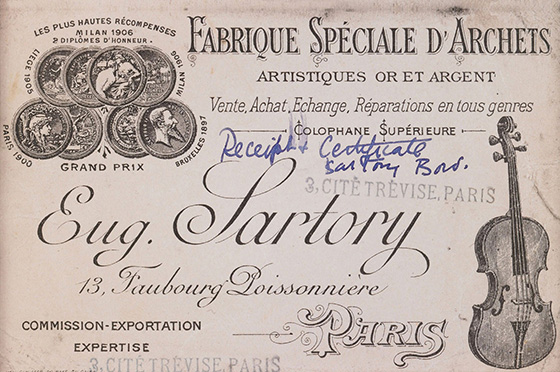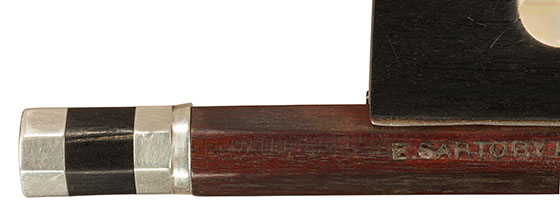Newsletter / May 2015
A Comparison of Three Sartory Cello Bows from the first three Expositions
Eugène Nicolas Sartory is without a doubt the most popular French bowmaker of the 20th century. His consistently high quality workmanship, combined with the fantastic playability of his bows, has elevated him above his contemporaries.
We have three of the rarest and finest Sartory cello bows. In this article, we will compare his early stylistic development from the 1894, 1897, and 1900 Expositions. These three bows also represent a young maker establishing himself as a world class shop owner, maker, and household name.
1894 Lyon Expo
The first example is the only cello bow from the 1894 Expo held in Lyon we have seen to date. This fine bow is a quintessential example of his first years of production, having very full chamfers, a long nose, and on the whole showing a strong stylistic similarity to J. A. Vigneron’s best conceived heads.
Eugène Nicolas Sartory / Expo 1894
The pinning on the button is similar to the corner pinning found on Lamy buttons, and the screw is threaded into the button unlike Sartory’s later work.
Eugène Nicolas Sartory / Expo 1894 / details button
The stick made of highly flamed pernambuco is a fitting choice for this ambitious bow maker’s first Exposition. The workmanship and choice of first rate pernambuco explain his award of a silver medal. It is of further interest that we now know Sartory used his first brand at least until 1894, not 1892 as previously published.
Eugène Nicolas Sartory / Expo 1894 / details brand stamps
1897 Brussels Expo
The second example is from the 1897 Brussels Expo. This mint condition cello bow represents the transition from the first period of Sartory’s production in 1894 to the later work.
Eugène Nicolas Sartory / Expo 1897
Made for the second exposition in which Sartory took part, this bow shows already a strong influence from J. A. Lamy in terms of basic headmodel. The use of ivory as a choice for frog material will not become common again until the 1930’s. Again with excellent workmanship and beautiful choice of pernambuco, we see why he was awarded a silver medal.
Eugène Nicolas Sartory / Expo 1897 / details brand stamps
1900 Paris Expo
The final bow we offer for comparison is a tortoise shell and gold mounted cello bow from the 1900 Paris Expo.
Eugène Nicolas Sartory / Expo 1900
Stylistically we can consider this Sartory’s typical model until the late 1920’s when they become heavier and stronger. This fine bow is branded E. SARTORY A PARIS twice. The EXPon 1900 brand also appears twice.
Conclusion
These bows also help us further pinpoint the transition from his rare first brand to his second. We can be sure that the transition came between the years of 1894 and 1897, updating the date of 1892 offered in the outstanding Millant and Raffin book “L’Archet.” Through careful examination of these fine examples, we can further understand Sartorys stylistic development from the beginning of his shop in 1889, to what we consider his typical and ultimately most recognizable style, which begins around 1900.
1894 EXPO / Head
1897 EXPO / Head
1900 EXPO / Head
1894 EXPO / Frog
1897 EXPO / Frog
1900 EXPO / Frog
Authors
Isaac Salchow, New York City / Stephan Jansen, Berlin
Photos
Rachel Drehmann, New York City
Copyright
Isaac Salchow, New York City / Stephan Jansen, Berlin – All rights reserved.















